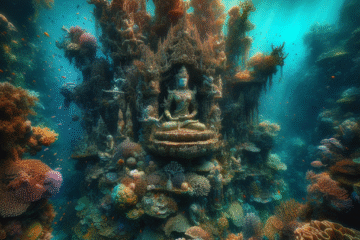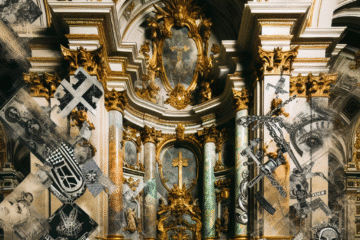
Image title: Pendant mask of Ìyọ́bà Idià
Medium: Ivory, iron, brass, coal, traces of iron oxides
Date: 16th century
Source:
The Met Collection
“
In skating over thin ice our safety is in our speed.
”
— Ralph Waldo Emerson
Carving Ice in the Desert: Ephemeral Sculptures Around the World
Introduction: The Art of Disappearance
In a world obsessed with preserving and archiving, ephemeral art offers a profound philosophical counterpoint: beauty that is meant to vanish. From the Buddhist sand mandalas painstakingly swept away after completion to the majestic crystalline corridors of ice hotels that melt in spring, these transient creations challenge our understanding of art’s purpose. They celebrate the process over the product, embrace impermanence, and often align deeply with cultural and environmental ideologies. This article explores the historical and artistic lineage of ephemeral sculptures, tracing their evolution across time and place—and reflecting on how technology and philosophy intersect with this compelling form.
Chapter 1: Ancient Transience – Ritual and Renewal
Ephemeral art is not a modern phenomenon. Ancient civilizations frequently used temporary structures and sculptures as part of ritual practice. For instance, in Mesoamerican cultures, large effigies made from organic materials such as straw, wood, or food were built for festivals and then ceremonially burned or dismantled. In ancient Rome, triumphal arches made of wood and plaster were erected just for parades. These artworks were never intended to endure—they were messages to the gods, celebratory markers of human achievements, or expressions of seasonal rhythms. Rather than devaluing their temporal nature, their fleeting existence was the point: a conscious, aesthetic embodiment of life’s cyclical nature.
Chapter 2: The Sacred and the Impermanent – Sand Mandalas of Tibetan Buddhism
Perhaps one of the most iconic examples of transient artistry is the sand mandala in Tibetan Buddhism. Created by monks who painstakingly pour colored sand into intricate, symmetrical patterns over days or even weeks, the sand mandala is an exercise in focus, precision, and spiritual discipline. Once completed, the mandala is ritualistically destroyed—swept into a jar and poured into a river—to symbolize the impermanence of all things. Rooted in the Buddhist concept of anicca (impermanence), these mandalas are both didactic and meditative, reinforcing inner detachment while dazzling spectators with their geometric elegance. These sacred patterns express an aesthetic philosophy where disappearance is not tragic but transcendent.
Chapter 3: Ice and Identity – Northern Fantasies in Frozen Form
Moving from sand to ice, in regions like Scandinavia and northern Japan, snow and ice festivals have transformed winter into a platform for creative ingenuity. Perhaps the most famous example is the Icehotel in Jukkasjärvi, Sweden. Rebuilt every winter since 1990 using ice blocks from the Torne River, the hotel is a functional artwork, housing rooms, bars, even chapels—all carved by artists from around the world. Harbin, China, hosts a similar festival, where enormous ice palaces are sculpted and illuminated by colored lights. These projects merge artistry with environmental design, using nature not simply as context but as medium. Their melting in spring is not mourned, but celebrated: an annual rhythm that re-sparks the imagination of both artists and visitors.
Chapter 4: Desert Dreams – Burning Man and the Alchemy of Sand
The Nevada desert is an unlikely canvas for art, yet every year a temporary city rises in Black Rock Desert during the Burning Man festival. At the core of this event are massive sculptures—some towering, kinetic, or interactive—that are often set alight in cathartic communal rituals. These works are more than decorative; they are ideological expressions. Burning Man’s ethos promotes radical self-expression, impermanence, and decommodified creativity. Many of the sculptures are designed to disappear in flames, echoing both ancient bonfire rituals and modern environmental critiques. The desert’s extremity becomes an aesthetic stage, encouraging artistic statements linked to transformation, identity, and temporality.
Chapter 5: Technological Ephemerality – Digital Installations and the New Temporality
In the era of digital media, ephemeral art has migrated from the physical to the virtual. Artists such as Rafael Lozano-Hemmer and teamLab create immersive light-based and interactive installations that disappear moments later or change based on viewer input. These digital artworks harness sensors, algorithms, and projection mapping to build experiences that are unrepeatable and unsaveable. Like their sand and ice counterparts, they embrace transience, but through pixels, sound, and code. Such works offer a modern meditation on impermanence in an age defined by data storage. They suggest a future where ephemerality is intentional—not due to material limitations but born of conceptual design.
Conclusion: Ephemeral but Enduring
Whether shaped in sand, carved from ice, burnt in fire, or encoded in light, ephemeral sculptures offer a compelling glimpse into how cultures interact with time, space, and matter. These artworks remind us that impermanence is not the enemy of meaning but a vehicle for it. In a rapidly changing world, they speak to adaptability, to the celebration of the moment, and to the idea that beauty, however temporary, leaves lasting impressions on those who witness it. It’s in these fleeting marvels that art reveals one of its most enduring truths: the power to affect, even as it disappears.

Image description:
Božská pomíjivost tónu v Podhradí nad Dyjí
License:
CC BY-SA 4.0
Source:
Wikimedia Commons
Useful links:


